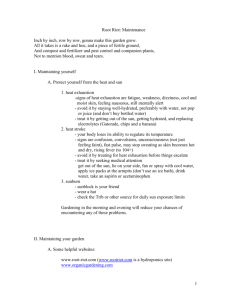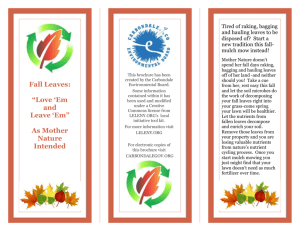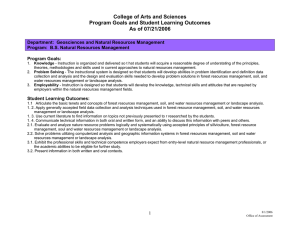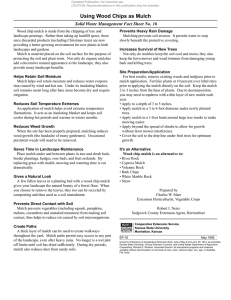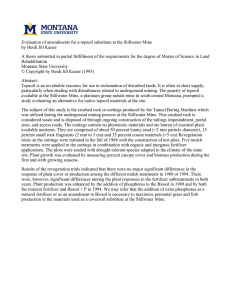The University of Georgia and Ft. Valley State University, the... partment of Agriculture and counties of the state cooperating. Co-
advertisement
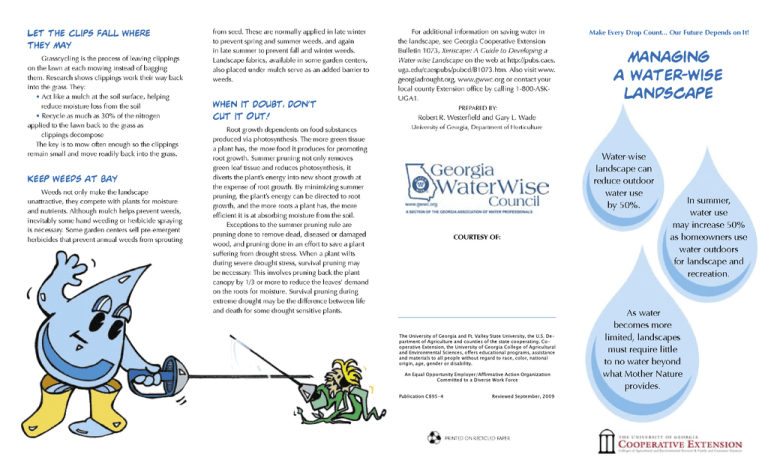
TheUni ver s i t yofGeor gi aandFt .Val l eySt at eUni ver s i t y,t heU. S.Depar t mentofAgr i cul t ur eandcount i esoft hes t at ecooper at i ng.Cooper at i veExt ens i on,t heUni ver s i t yofGeor gi aCol l egeofAgr i cul t ur al andEnvi r onment alSci ences ,of f er seducat i onalpr ogr ams ,as s i s t ance andmat er i al st oal lpeopl ewi t houtr egar dt or ace,col or ,nat i onal or i gi n,age,genderordi s abi l i t y. AnEqualOppor t uni t yEmpl oyer /Af f i r mat i veAct i onOr gani zat i on Commi t t edt oaDi ver s eWor kFor ce Publ i cat i onC895-4 Revi ewedSept ember ,2009 W ater-wise landscapes not only save water, they save time by requiring less routine care than most traditional landscapes. Plants in a waterwise landscape are carefully selected for the site and grouped together according to their water needs. Then, cultural practices are used to maximize the soil’s ability to hold water and to minimize plant water loss. When a landscape achieves water-wise status, at least 60% of the total landscaped area is considered “low water use” and watered exclusively by Mother Nature. One goal in managing a water-wise landscape is to minimize new vegetative growth. Lush new growth is the first to wilt when water becomes limited. New leaf growth also increases the demand on the roots for water and nutrients, which is a problem during periods of limited rainfall. Generally, the more we stimulate plants to grow, the more care they require, and the more resources are required to maintain them. Another goal in managing a water-wise landscape is to conserve moisture in the soil and reduce evaporative water loss. This publication offers guidelines to help you achieve these goals and conserve water when managing your landscape. Mulching is a Must! Mulch is a great asset in a water-wise landscape. Organic mulches, such as pine straw, pine bark mulch, or shredded hardwood mulch, conserve water. These fine-textured mulches hold moisture in the soil, yet they are porous enough to allow water to infiltrate into the soil. Unfortunately, organic mulches decompose, shrink in volume, and need replenishing regularly. For best water conservation, maintain 3 to 5 inches of mulch on the soil surface at all times. Generally, one bale of pine straw covers 50 square feet when applied to a 5-inch depth. One cubic yard (14 - 2 cu. ft. bags) of bark mulch covers 100 square feet to a 3-inch depth. Several municipalities and power companies collect and grind woody brush left curbside by citizens, then make it available as mulch. Drip is Dandy on Flowers An efficient way to water annual flowers, roses and herbaceous perennials is with drip irrigation tubing or ooze hose. The hose can be woven in a serpentine fashion throughout the bed and placed under the mulch. Drip irrigation avoids spraying the foliage so it does not encourage disease. It also applies water directly to the roots, so there is much less evaporative loss of water. Less is More when Fertilizing Most established, healthy trees and shrubs only need fertilizer once every two to three years. Most established herbaceous perennials perform well when fertilized every other year. If you do a good job of building up organic matter in the soil, plants can extract essential mineral elements they need from the soil and will not require annual fertilization. Annual flowers and roses are exceptions — they require regular feeding to grow and flower well. Nitrogen, the first number in a fertilizer analysis, stimulates new growth, and new growth is the first to wilt during periods of limited rainfall. Furthermore, when shoot growth increases, root growth decreases, so the roots are less efficient at extracting moisture from the soil. When selecting a fertilizer for ornamental plants, look for one that is less than 15% nitrogen. Then, apply it at a low rate (a low rate would be 1 lb. of actual nitrogen per 1,000 sq. ft.) To calculate the application rate, divide the first number in the analysis into 100. For instance, a 12-4-8 fertilizer would be applied at a rate of 8 lbs. per 1,000 sq. ft. (100/12 = 8.3 or 8 rounded off). Never fertilize during dry periods because fertilizers are chemical salts and may dehydrate roots. Also, never fertilize prior to rainfall, because heavy rain may wash valuable nutrients down the storm drain into rivers and streams where they can become pollutants. The best time to fertilize ornamental plants in the landscape is late winter, just before spring growth begins. Research shows that plants absorb more fertilizer when they are actively growing, and they absorb little to no fertilizer when they are dormant. Fall fertilization is not recommended because it has been shown to decrease winter hardiness of some plants. Aeration Helps the Flow Turfgrass specialists recommend aerating lawns at least once a year. A lawn aerator makes holes in the turfgrass approximately 2 to 4 inches deep and 1/2-inch wide. Improves the percolation and movement of water and nutrients into the soil: • Decreases run-off • Encourages the roots of turfgrass to grow deeply and to become more drought tolerant Water Only Plants That Need IT Water those plants that show signs of moisture stress. Plants under moisture stress turn a gray-green color or wilt. When hand watering, make certain you apply water slowly at a rate the soil can absorb. Use a water-breaker on the hand-held hose to soften the impact of the water on the ground. If water starts running off the site, you are applying it too rapidly. Either turn down the pressure or make several passes with the handheld hose over the same area to give soil time to absorb the water.


